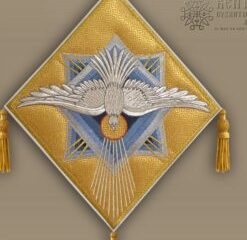Sister Parakliti, Holy Skete of Saint Mary Magdalene, in Liti
This year, we’d like to dedicate the great virtue, that of love, to the memory of Saint Mary Magdalene.
In volume two of the Philokalia, we find the ‘Four Hundred Texts on Love’ by Saint Maximos the Confessor. There are many sayings by the saint, but we shall focus on the first two of the first hundred: ‘Love is a holy state of the soul, disposing it to value knowledge of God above all created things. We cannot attain lasting possession of such love while we are still attached to anything worldly’ (1st text).
This good disposition seeks knowledge of God, requires that we have the intention to know God, that is to love learning about God. Love is the source of this pursuit and knowledge strengthens this love and nourishes it. If our own disposition is to become good, it has to resemble the goodness of God; it’s as if we’re saying that we have God’s disposition, because he alone is good.
It was Mary Magdalene’s knowledge of Christ that made her seek him after his death, despite the fact that she was naturally in mourning, since she’d just lost the Lord. She knew, however, that the relationship with such a teacher wouldn’t die because of death. His body may have been buried, but it wasn’t possible for her faith, the relationship she’d had with him, to be buried. Everything was still alive within her. Even after his physical absence, she continued to seek him. This frame of mind was so entrenched that the fact of his death made no difference to it. She was so faithful to Christ’s presence, even when he was dead. She was aware, inside herself, that this presence had another dimension, although she didn’t as yet know what. He was the cause of her good disposition. A disposition which didn’t retreat, didn’t look back. So she went to the tomb at first light. In her mourning, in her waiting with the myrrh, and in the pain of her heart over her great loss, Saint Mary Magdalene expresses the feelings of everyone who’s in pain. She’s a model for all those who’ve lost someone near and dear, and she reminds us that the relationship remains real. She didn’t lose Christ; he was always present within her.
How often have we, too, sat like this, in pain, empty-handed, facing the human loss of a person we love. How like Saint Mary Magdalene we are at such times.
She didn’t cry because she was agonizing over whether she would enter the Kingdom of God or not. She didn’t weep in a formal way over a sin and out of fear of the Law of Moses. We often weep over a sin because it affects our self-image or because we’ve broken a rule. But real tears are always over a relationship and its breakdown. They have to do with love, because with sin there’s always the chance that we’ll lose a relationship or that love will grow cold. The saint was praying over a presence and an absence. Naturally, her mourning over these terrible events prevented her from thinking about the resurrection. At that particular time, it was impossible for her to think about such things. Not all Christians are always ready, at a time of mourning, to see everything through the eyes of faith and the resurrection. It takes time.
Of course, love is linked to mourning. Over whom are we weeping? The person we love. But here Saint Maximos presents us with other dimensions of love. A love more powerful than death. A love that lives for ever. This dispassion doesn’t end here on earth*. If we focus on the word ‘love’, each of us can say something from their experience and can reveal how nourished their soul has been by love. Some might say they’ve been wounded by their love. But when a good disposition is united with love of Christ, it becomes a mystery.
The mystery of Christ’s eternal love is never going to abandon a true, good and stable disposition, even in sorrow. Christ in pain, Christ crucified, who forgave the soldiers who’d been mocking him the day before, would not have left his true disciple and her soul to writhe, without consolation. Christ knows about pain, as he also knows true love, and so he didn’t leave Magdalene sitting with the myrrh, in the solitude of her grief.
Christ is with us in our grief, in our sickness, in our trial and in our loss. He’s with us and addresses us by name, as he did Magdalene: ‘Mary!’. All we have to do is go to him and weep, to seek his face in our grief, so that he can enlighten us and explain how we should deal with what has happened. Since he experienced the most extreme pain on the cross, he knows about pain and being tested. So, he alone is able to stand by us.
Magdalene wept for Christ at his tomb. She wanted to share everything with him. And we, too, can weep with Christ over someone we love, asking to be able accept the event, asking for faith in the resurrection, faith that, although he or she is in the ground, the person hasn’t been lost, but lives. We can ask God to give us a sense of the presence of the person, so that we can continue our relationship with them in a different way. After a loss, we need time and strength to find the courage to deal with what life brings us, so that we can continue on our way.
* This a reference to the 2nd text of the four hundred: ‘Dispassion engenders love, hope in God engenders dispassion, and patience and forbearance engender hope in God…’.
The pyrograph depicted is from the workshop of the Holy Skete of Saint Mary Magdalene, in Liti, Langadas.
Source: pemptousia.com




0 Comments